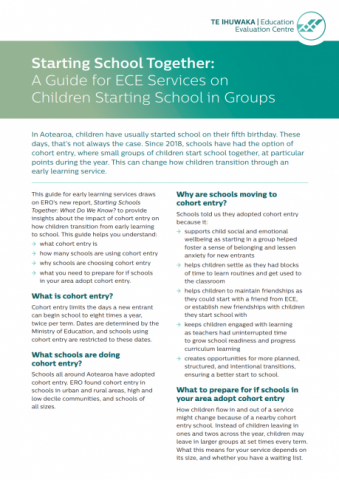Summary
In Aotearoa, children have usually started school on their fifth birthday. These days, that’s not always the case. Since 2018, schools have had the option of cohort entry, where small groups of children start school together, at particular points during the year. This can change how children transition through an early learning service.
This guide for early learning services draws on ERO’s new report, Starting Schools Together: What Do We Know? to provide insights about the impact of cohort entry on how children transition from early learning to school. This guide helps you understand:
- what cohort entry is
- how many schools are using cohort entry
- why schools are choosing cohort entry
- what you need to prepare for if schools in your area adopt cohort entry.
Whole article:
A Guide for ECE Services on Children Starting School in GroupsWhat is cohort entry?
Cohort entry limits the days a new entrant can begin school to eight times a year, twice per term. Dates are determined by the Ministry of Education, and schools using cohort entry are restricted to these dates.
What schools are doing cohort entry?
Schools all around Aotearoa have adopted cohort entry. ERO found cohort entry in schools in urban and rural areas, high and low decile communities, and schools of all sizes.
Why are schools moving to cohort entry?
Schools told us they adopted cohort entry because it:
- supports child social and emotional wellbeing as starting in a group helped foster a sense of belonging and lessen anxiety for new entrants
- helps children settle as they had blocks of time to learn routines and get used to the classroom
- helps children to maintain friendships as they could start with a friend from ECE, or establish new friendships with children they start school with
- keeps children engaged with learning as teachers had uninterrupted time to grow school readiness and progress curriculum learning
- creates opportunities for more planned, structured, and intentional transitions, ensuring a better start to school.
What to prepare for if schools in your area adopt cohort entry
How children flow in and out of a service might change because of a nearby cohort entry school. Instead of children leaving in ones and twos across the year, children may leave in larger groups at set times every term. What this means for your service depends on its size, and whether you have a waiting list.
Some children may stay a little longer
ECEs told us what can happen if five-year-olds stay with the service for longer because of where their birthday falls in the cohort entry schedule. For example, a child who turns five at the end of November may not start school until mid-February. This can impact your service’s waiting list, as new children cannot start until they have left. It can also affect the curriculum, as kaiako may need to respond to the learning and wellbeing needs of five-year-olds alongside younger learners. You may want to consider:
- if a local cohort entry school will mean having older five-year-old children at your service sometimes
- how well-prepared your kaiako are to support the learning, engagement, and wellbeing of older children.
Children could leave in groups, impacting your roll
Services with small or no waiting lists told ERO about a drop in numbers when groups leave together and there are no or only one or two children waiting to take their place. This has funding and staffing implications for a service if there is a delay in new children starting. Services may also experience shifts in the overall dynamics of the wider group of children, as groups of teina join the service while tuakana move on. You may want to consider:
- connecting with local cohort entry schools to understand their enrolment processes and timing, and how you can work together during transition times
- looking at staffing levels, ratios, roll management, settling and care rituals, transition visits, support for tuakana-teina peer interactions, or opportunities for new whānau to connect.
Children leaving together supports transitions
Schools and ECEs told us that cohort entry was an opportunity to strengthen their relationships and work together to ensure transitions to school were positive for new entrants. Schools and services could plan transition visits and activities. When schools and services communicated regularly, ECEs could plan for the flow of children out of their service, and support whānau by letting them know what to expect for their children starting a cohort entry school.
If more schools move to cohort entry, it is likely children in your service will prepare to start school this way. Taking time to connect and work with your local school can help your service adjust to this change whilst supporting children’s positive transition experiences.
For more information about cohort entry in NZ visit: https://www.education.govt.nz/school/managing-and-supporting-students/starting-school/
For useful insights and reflective questions around transitions that reflect the principles of Te Whāriki visit: https://tewhariki.tki.org.nz/en/teaching-strategies-and-resources/wellbeing/pathways-and-transitions/
To locate a cohort entry school: https://www.educationcounts.govt.nz/find-school
